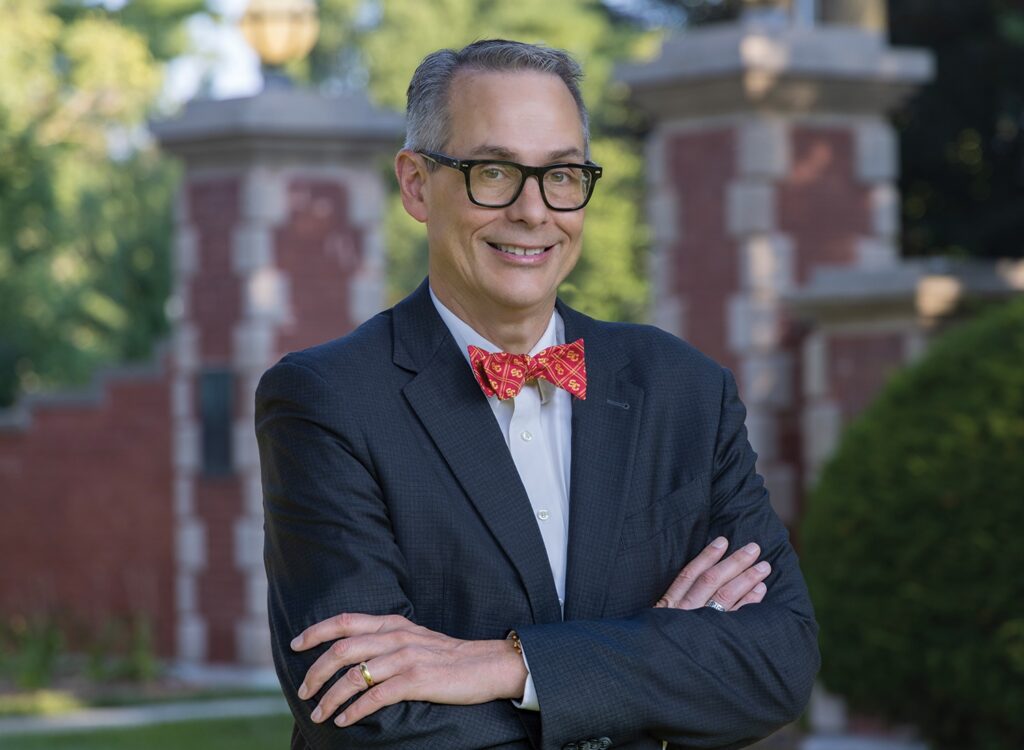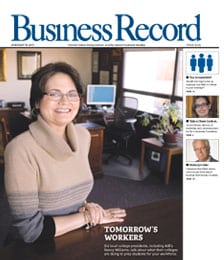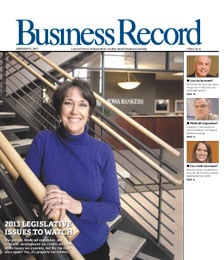Straddling Iowa’s past and future

On Dec. 3, Brooklyn, Iowa, dairy farmer Craig Lang drew thunderous applause from hundreds of Iowa Farm Bureau Federation members at the organization’s 85th annual meeting, telling them their way of life was under assault.
Gesturing with large hands weathered by years of hard outdoor physical labor, he called for solidarity among the state’s farmers. He told members that various advertisements, public comments and letters to newspaper editors protesting some agricultural practices were a danger to all farmers. Then he brought his thick fingertips together to form a steeple close to his chest, and he drove his point home.
“Today there are individuals and groups that have made it their mission to harass producers,” he said. “A growing number of farmers are being targeted and harassed… When these producers are attacked, your way of life is being attacked.”
As head of the Grow Iowa Values Fund and president of the Iowa Farm Bureau, Lang is both shaping the state’s economic future and working to protect its oldest and most traditional industry, agriculture. It is a daunting task. Supporters say it would be difficult enough just balancing his responsibilities to the Farm Bureau with his 400-cow dairy operation, which he tends on weekends.
“I sometimes think, ‘Good Lord, I don’t know how he does those two,'” said Michael Blouin, director of the Iowa Department of Economic Development. “I just hope he sticks around [the Values Fund] awhile. It’s a tough job. It’s time consuming. People are constantly knocking on your door or calling you on the phone to tell you what needs to be done.”
Indeed, each of Lang’s roles is filled with challenges. Iowa’s rural communities have been steadily losing residents since World War II. Youngsters continue to leave for bigger cities and brighter opportunities. Competition, government policies and thin profit margins have encouraged consolidation.
Meanwhile, the economic downturn of 2001 and 2002 continues to weigh on urban Iowa. The state’s unemployment rate stood at 4.4 percent in December, up from 3.8 percent a year before. The manufacturing sector, which generates more than 20 percent of the state’s gross product, is still shedding jobs as companies such as Maytag Corp. streamline factories in the United States and move production to Mexico. More than 3,300 manufacturing-related jobs were lost in 2003, according to Iowa Workforce Development, which tracks employment figures.
The Grow Iowa Values Fund was proposed last year by Gov. Tom Vilsack as a tool to stanch job losses and spark a fundamental shift in Iowa’s economy toward higher-paying knowledge and service-sector jobs. Using $100 million in federal money and an estimated $400 million from the state, Vilsack asked that the Values Fund focus both on attracting innovative companies to Iowa and on helping existing Iowa companies invest in new equipment and facilities to keep jobs here.
Almost from the start, the Values Fund has been in financial trouble itself. It received the first of two $50 million installments from the federal government last year, and its board of directors quickly spent most of it on nearly a half-dozen grants, including projects for Wells Fargo & Co. and Trans Ova Genetics, a biotechnology firm in Northwest Iowa. The Values Fund is set to get the second infusion of federal money this summer.
Its funding from the state was more complicated, relying on a growth in sales tax revenues that hasn’t occurred because of the state’s anemic economy. So far, no money has been kicked in by the state, and with state legislators dealing with budget shortfalls, there is doubt over whether the money will be found at all. That fact has not prevented companies from applying for assistance. The Iowa Department of Economic Development reports there are scores of companies that have asked for funds.
“Finding opportunities to invest in is not a problem,” said Values Fund board member Gary Kirke. “[Lang’s] leadership is important in prioritizing projects to make Iowa grow.”
Over the years, Lang has built a reputation as a consensus builder, and supporters said that is exactly the kind of leader the Values Fund needs amid efforts to get it on firmer financial footing.
“Craig is more of a hands-on guy, and going forth from here on, he’s exactly what we need,” Blouin said. One of Lang’s biggest challenges is likely to be juggling demands from rural and urban areas, some said. Lang himself said his loyalties lie first with rural Iowa.
“There’s a tug of war between the urban areas and rural areas for Values Fund money,” said Holmes Foster, a former banking superintendent whose resignation as chair of the Values Fund elevated Lang to the position. “[Lang] is going to be lobbied by the rural force, rural areas, for their share. … I would think from the standpoint of rural areas that they tend to have some confidence in Craig that they would be treated fairly.”
Given his background, Lang understands as well as anyone the problems facing the state’s agriculture-based communities. He says he will work to put rural Iowa first.
“I will do by best to influence the committee to make sure rural Iowa gets [its] share of the funds,” he said. “Every decision I make is based on my role as Farm Bureau president.”
Lang would initially seem an unlikely leader of the Values Fund, whose goal is to attract advanced manufacturing companies and biotech-related firms and add jobs in the state’s information services sector. He was first named to the board by Gov. Vilsack as a representative of the state’s agribusiness interests. He became chairman on Oct. 22, after Foster resigned.
Lang graduated from Iowa State University in 1973 with a degree in dairy science. On the drive home from Ames following graduation, Lang said he thought about the opportunities the family farm could provide, including working with animals, developing sales skills and expanding the operation.
He decided to stay, and has since increased the size of the farm from 240 acres to 1,000. The number of cows has risen by tenfold, and the farm today also grows corn, soybeans and alfalfa.
At the Farm Bureau, Lang is working to expand the political strength of an already powerful lobbying organization by adding members. His changes there are creating pressures, too.
For instance, the Farm Bureau is using its size to get health insurers, automobile dealers, pharmacies and other service organizations to offer preferential rates to its members. The tactic is attracting non-farmers to the Farm Bureau, whose membership today stands at more than 152,000 families.
Only 80,000 of its members are working farmers, Lang said. Even that figure could be a stretch. Each county sets its own standards for whether an individual is a “farm-supporting member or a Farm Bureau supporting member,” Lang said. Some counties, for instance, argue that grocery store owners, restaurant owners and implement dealers have “a stake in the industry,” he said.
His call for members to present a united front, exemplified during his December speech, comes at a time when the organization faces outside pressure from environmental organizations and urban factions, and internal schisms between corporate farmers and small operations.
“Our group does not, I’ll be honest with you, like corporate agriculture,” Lang said. “But some of our members represent corporate agriculture because they’ve been forced there because of business decisions.”
What’s more, the organization often rails against Iowa’s big-city population, even as it becomes more dependent upon attracting urban members to boost its ranks. For example Lang described a scenario in which a city dweller moved to an acreage near a working farm.
“Livestock producers would be in place, and they had already been there for some time,” Lang said. “Then someone moves in across the street and they think that’s a nuisance. Well, we believe that livestock producers need some kind of protection for their operation.”







